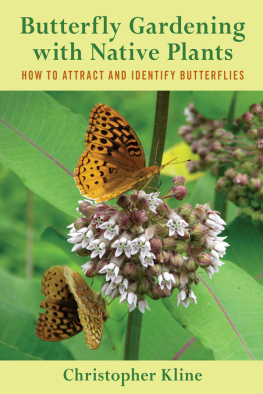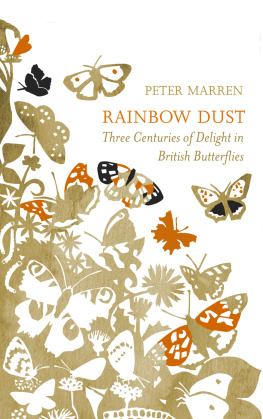
Copyright 2013 by William R. Leach
All rights reserved. Published in the United States by Pantheon Books, a division of Random House, Inc., New York, and in Canada by Random House of Canada Limited, Toronto.
eBook ISBN: 978-0-307-90787-5
Hardcover ISBN: 978-0-307-42293-5
Pantheon Books and colophon are registered trademarks of Random House, Inc.
Library of Congress Cataloging-in-Publication Data
Leach, William, [date]
Butterfly people : an American encounter with the beauty of the world / William Leach.
p. cm.
Includes bibliographical references and index.
ISBN 978-0-375-42293-5
1. ButterfliesUnited StatesHistory19th century.
2. EntomologistsUnited StatesHistory19th century.
3. Industrial revolutionUnited StatesHistory19th century. I. Title.
QL549.L43 2012 595.789097309034dc23 2012000389
www.pantheonbooks.com
Front-cover art ( bottom row, center ) by Ferdinand Heinrich Herman Strecker; ( all others ) Mary Evans Picture Library
Cover design by Kelly Blair
Book design by M. Kristen Bearse
v3.1
In memory of Jeannette Hopkins Beauty has no obvious use; nor is there any clear cultural necessity for it. Yet civilization could not do without it. SIGMUND FREUD I did not dream of there being such splendid things in the world. ADRIAN LATIMER of Lumpkin, Georgia, to Herman Strecker, January 27, 1880
Contents
Preface
NEARLY ALL MY LIFE I have been drawn to butterflies, among the most beautiful things in nature. As a nine-year-old boy I began collecting in and around a graveyard, in a field that led down to a railroad line, and at the margins of a streambed that ran along the railroad, all within easy reach of my home in a neatly packed lower-middle-class neighborhood. Nothing else so fulfilling or exhilarating marked my childhood. In my minds eye I see myself running, rushing, falling on the ground, heart pounding, intense beyond belief, lost to an all-consuming purpose. But I stopped collecting abruptly, for want of continuing reinforcement and the absence of informed guidance. I returned to it in my late twenties and, again, in my mid-thirties, in the glorious Cumberland Plateau in Tennessee, where I first saw the Diana fritillary and the zebra swallowtail in all its seasonal phases. Then I stopped for good, although, in spirit, I hardly changed at alldespite the rising climate against collecting and my own misgivings about killingbecause collecting took me out of myself and far into nature as nothing else could ever have done. It let me forget time and turmoil and defy many odds, and to see a multitude of living forms. It opened me to the sensuousness of the natural world, which reflected my own inner energies; the color in me met the color outside me. Yet I never took a course on insects or acquired a much greater knowledge until I decided to do this book, the research and writing of which have now cost me many years. I have written it in homage to my own past as well as to great Americans, collectors of all sorts (including some German and English butterfly people) as they came to know butterflies, first in America after 1850, then in the tropics after 1885.
But the book became more than that. It became a story of the American awareness and experience of the beauty of the world, in both its natural and its artificial forms, spanning many years. Soon after the Civil War, Americans of all classes came in contact with natureand with butterfliesin pervasive ways. This was a remarkable thing in its own right, for never before had so many people come to know so many butterflies, native and foreign; never before had so many entered the kingdom of form, as the American philosopher George Santayana put it in his 1896 Sense of Beauty, one of the most insightful books of the age. At the same time, the country underwent a massive industrial transformation, which produced a vast number of human-made artifacts, many seen for the first time at the worlds fairs, competing with butterfliesand other natural formsfor beauty. This, too, was a remarkable occurrence, opening up aesthetic frontiers of all kinds to more people in an unprecedented way. As Walt Whitman observed, it seemed as if Americans were about to know nature and artifice together at once, not as adversaries but as collaborators in the enrichment of life, and such, he believed, would continue to be the case, so long as a balance endured between them. But, as he feared, the balance did not last, and one form of beautythe industrial, technological kindbegan to take precedence, and at great cost to nature and to butterflies. So here, then, was my story: how Americans came to know the butterflies and, subsequently, how the butterflies (as exemplary of all natural beauty) began to lose out in the contest with another form of beauty, the industrial-artifactual one, and what that victory meant not only for the well-being of the natural world but for the well-being of American culture as well.
The whole investigation was deeply gratifying for me, to make up for years of ignorance. Im afraid I never overturned my deficit; nor had I ever expected to, since I had no desire to become a professional expert on insects. Nevertheless, I learned a great deal more about butterflies and about the history of Americas attachment to butterflies and of its complex relationship with the beauty of the world as well as of my own. I learned, too, how critical the study of these insects had been to the understanding of the natural world, not merely at the margins of inquiry but at the very core of it; for a brief moment in the 1870s and 80s, some of the most advanced naturalists of Europe and EnglandCharles Darwin, August Weismann, Henry Bates, and Alfred Russel Wallace, among themdwelled on butterflies as a way to illuminate the origin and evolution of species, and Americans, too, were at the forefrontleading all the others, in fact, in the depth and range of their insights, embracing Darwins theory of natural selection as the driving engine of evolution, even as most naturalists at the time rejected or denounced it. I also learned that butterflies captured the imagination of thousands of other men and women (besides the natural scientists), just as butterflies had captured mine when I was a boy, never to lose their hold on me.
Introduction
For a fleeting moment, however, the reign of the butterflies, and of all similar natural life, held sway in the imaginations of many American men and women.
Two phenomena were responsible, in particular, for this history, each ushering people into the natural world with unsurpassed effect. The first was economic and technological and was connected to the rise of capitalism; the second was cultural and institutional and was exemplified by the tradition of Enlightenment natural history, having at its heart a passion for the diversity and beauty of natural forms. One was extractive, the other adoring, and both derived from the thousands of years of experience the Europeans and English imported with them to America. Both existed in the same country and the same people, from Thomas Jefferson to Theodore Roosevelt and beyond. America was founded as a kind of European achievement, the beneficiary, as it were, of centuries of struggle, at once armed with the brilliance to build a new economic empire and endowed with the heritage to understand and protect the natural world.
The American economy had many aspects dependent on nature as landed wealth or property, and that brought Americans close to nature. No economic system had ever done this more thoroughly or swiftly. In what seems a twinkling of historical time, it carried people across the continent in search of land, minerals, virgin forests, and fossil fuels, a situation speeded up by a remarkable series of land surveys and revolutionized by the Will Doherty of Mount Auburn, Ohio, who spent most of his brief life in pursuit of the rarest of species. Extraordinary collections of butterflies in America issued from this descent below the equator. The biggest private one was cobbled together by Herman Strecker of Reading, Pennsylvania, a poor stonecutter with a wild yearning for the things of endless joy, as he called his insects.
Next page












